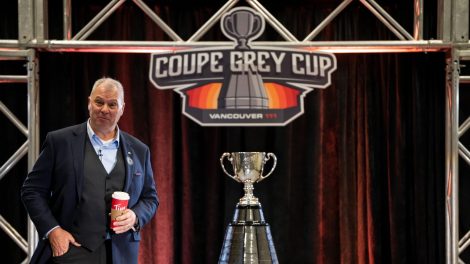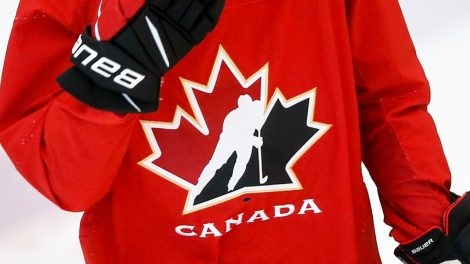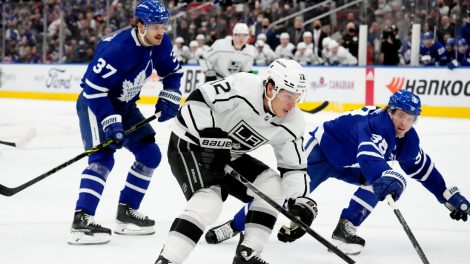TORONTO – It won’t always be like this.
After a dozen autumns of hibernation, the reborn World Cup of Hockey arose bold and weird and, at the best of times, beautiful.
Fair and lopsided, clunky and fresh, the best-on-best tournament has battled through criticism, multiple national-program-questioning upsets, clumps of vacant Air Canada Centre seats, soft U.S. TV scores, and an American League wild-card race just three Bautista-long-tosses west.
“There’s not a lot of Torontos,” says NHL deputy commissioner Bill Daly. “Even for this market and its hockey passion, it was at times challenging.”
So when the World Cup resurfaces next—be it in three, four or five years, according to NHL commissioner Gary Bettman—you can bank on only one thing: change.
“I’m sure there’ll be changes,” says Ryan Getzlaf, one of Team Canada’s 12 first-line forwards. “When you’re talking about putting together an event in a year and a half, you definitely have to look at it and figure out what you’re going to do next.”
Everything will be evaluated and reevaluated after the Toronto experiment. The year the next one is played, the time of season it takes place, the number and makeup of teams involved, the number and location of the host cities, the television rights, the puck drop times and ticket packages, the pool groups and best-of-three final. Everything.
We could see the Cup expand its global reach to include a qualification round, with expected potential host cities being asked to bid for the privilege.
“You must evolve or you regress,” says Bettman. “This event was about growing the game, and growing the game internationally. It’s a stepping stone.”
Depending on who you ask, those steps were either made in the right direction or the wrong one.
"The World Cup is great. It's not the Olympics. Let's not get confused." —Mike Babcock #WCH2016
— luke fox (@lukefoxjukebox) September 27, 2016
Team Canada coach Mike Babcock has strong feelings on the format. He hears just one lonely anthem played before an international final and notices something’s off.
“I like country on country. I like the opportunity to represent your country where the heat’s on you and you gotta deliver. That’s a huge part of the Olympic Games,” Babcock days. “The World Cup is great. It’s not the Olympics. Let’s not get confused.”
Babcock would like pool groups dictated by international ranking, like the Olympics or World Championship. He goes so far as to say the top seed should get first dibs on dressing rooms, just as the fastest swimmer draws the best lane. (An easier stance to take when you’re the Michael Phelps of hockey coaches.)
“Two cities. Only night games. Bring the pools together. Close, close together, so you have crowds every night, so you’re not moving people around,” Babcock suggests.
Hesitant to voice his opinion until surveyed by the Players’ Association, Canada’s Matt Duchene agrees with his coach.
“I’m a traditionalist,” Duchene says. “That’s not to slight the North Americans or this Team Europe—they’ve deserved everything they’ve gotten. They’re a great group. I’ve seen their quotes. Even them, it means more to play for a country than an all-star team. I like the traditional side of it, absolutely.”
Babcock’s correct: This is not the Olympics. So maybe it shouldn’t pretend to be. Though it came at the expense of golden Sweden-Canada rematch or a USA-Canada ratings windfall, the tournament’s greatest successes were its gimmicks.
“The big discussion will be Team North America and Team Europe,” says Europe coach Ralph Krueger, loving the current format. “To get 184 of the best players in the world on the same stage has never happened in this magnitude and in this concentration.
“It’s a celebration of hockey, and we’ve possibly put the party on its head a bit.”
The NHL and NHLPA must decide what kind of party they want to throw.
What is the true purpose of the World Cup? To grow the game? To include the most NHLers possible? To showcase young talent that would be in tough to make their national squads? To make as much hockey-related revenue as possible? To replace the Olympics as the international best-on-best?
If it’s to gather the greatest concentration of elite talent in one place, North America and Europe stay. If it’s to slow-grow the game in as many countries as possible, again, this was a smart move.
“Part of the competitiveness,” Bettman says, “was a function of the fact that Team Europe and Team North America were certainly more competitive than the seventh and eighth countries would’ve been.”
Ryan O’Reilly says this is the fastest hockey he’s seen. Christian Ehrhoff calls this “the best tournament that’s ever been.” Brent Burns, who believes the World Championship is too drawn out, not only raves about this Cup’s intensity, he sees Anze Kopitar on TV skating with Slovenian children and understands Team Europe’s endgame.
“In 15 years, those kids will be playing here, and who knows if they would’ve got that chance? That’s what hockey’s about. As much as it’s about scores, at the end of the day it’s about keeping people out of trouble and having a special bond,” Burns says.
“The hockey’s unbelievable. To have best-on-best in one city, two games a day, it’s tough to beat.”
As a marketing tool, Team Europe could do wonders overseas.
“Even though I’m the only Austrian, the following [back home] is much better than I thought heading into this tournament,” says Thomas Vanek. “If you want eight really good teams, then I believe you have to keep Team Europe and North America. No disrespect to 7 and 8, Slovakia and Switzerland, but would they have the success that this team is having?”
Pierre-Édouard Bellemare, who scored more goals than Patrick Kane here, has stirred a hockey buzz in France because of Europe’s success. (Good timing — Paris will co-host the 2017 IIHF World Championship.)
“Think about that,” Krueger says. “You don’t get immediate results in new markets—that will show up over time. Drip, drip, drip—hockey will be better in those eight countries.”
Ironically, Europe and North America—rare eurekas sprung from a conservative league—were too good for their own good.
“This Young Guns team was spectacular. Next time, is there going to be a McDavid and a Matthews?” Babcock warns. “So you better be careful what you do with that. Team Europe has done a great job. They’re right here in the final. It’s pretty hard to knock it.”
Europe GM Miroslav Satan laughs when we ask him if his group’s excellence will ultimately lead to its death.
“Maybe our success will have something to do with what happens next time around, but I’m not sure which way it will influence,” he says. “It worked for us. Maybe not for some other countries. I’m happy how they did it. For the future, I don’t know.”
Satan outlines the case for bringing back Team Europe.
“The single reason for keeping it is making hockey popular in these small countries where there is not as much attention as there is in Canada or the U.S.,” Satan says. “You’re giving a chance to guys from the small countries to be in the World Cup. Look at Anze Kopitar. Look at Vanek, Zuccarello from Norway, Bellemare from France. A single guy representing a whole country at the World Cup.”
Soon, the decision-makers must determine if they want to push forward with doing things a little fresh and different, or if they wish to circle back to a safer script.
“This is something new for me,” Getzlaf says. “I don’t have a lot of new at this point in my career, so it’s been great.”








